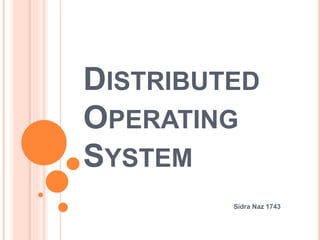
Distributed os
- 2. CONTENT LIST Introduction Types of distributed OS Communication structure
- 3. INTRODUCTION Distributed operating system is a model where distributed applications are running on multiple computer linked by communication. These systems are referred as loosely coupled systems where each processor has its own local memory and processors communicate with one another through various communication lines, such as high speed buses or telephone lines. This system looks to its users like an ordinary centralized operating system but runs on multiple, independent CPU.
- 4. INTRODUCTION (CONT) The users of a true distributed system should not know, on which machine their programs are running and where their files are stored. LOCUS and MICROS are the best examples of distributed operating systems.
- 7. TYPES OF DISTRIBUTED OPERATING SYSTEM There are two types of operating system Networking operating system Distributed operating system Advantages Disadvantages
- 8. NETWORKING OPERATING SYSTEM A Network Operating System runs on a server and provides the server the capability to manage data, users, groups, security, applications, and other networking functions. The primary purpose of the network operating system is to allow shared file and printer access among multiple computers in a network, typically a local area network (LAN), a private network or to other networks. Examples of network operating systems include Microsoft Windows Server 2003, Microsoft Windows Server 2008, UNIX and Linux.
- 9. DISTRIBUTED OPERATING SYSTEM Users not aware of multiplicity of machines. Data Migration – transfer data by transferring entire file, or only portion of file. Computation Migration – transfer the computation, rather than the data across file. Process Migration – execute an entire process, or parts of it, at different sites.
- 10. COMMUNICATION STRUCTURE Communication Structure is the pattern of interaction. The design of a communication network must address four basic issues: Naming and Name Resolution Routing strategies Connection strategies Contention
- 11. Naming and Name Resolution The first component of network communication is the naming of the systems in the network. Processes are generally identified by the pair host name, identifiers. Domain name service (DNS) – specifies the naming structure of the hosts, as well as name to address resolution.
- 12. Routing strategies Fixed routing-A path from A to B is specified in advance and does not change unless a hardware failure disables it. Virtual routing-A path from A to B is fixed for the duration of one session. Dynamic routing-The path used to send a message from site A to site B is chosen only when a message is sent.
- 13. Connection strategies: Circuit switching - A permanent physical link is established for the duration of the communication. Message switching - If two processes want to communicate, a temporary link is established for the duration of one message transfer. Packet switching-One message is to be divided into a number of packets. Each packet is sent to its destination separately, and each therefore must include a source and destination address with its data.
- 14. Contention: Techniques to avoid repeated collisions include: CSMA/CD - Carrier sense with multiple access (CSMA); collision detection (CD) -Before transmitting a message over a link, a site must determine whether another message is currently being transmitted over that link. If two or more sites begin transmitting at exactly the same time, then they will register a CD and will stop transmitting. Token passing - A unique message type, known as a token, continuously circulates in the system, a site that wants to transmit information must wait until the token arrives and when the site completes its round of message passing, it retransmits the token for other sites to transmit messages.
- 15. Communication Protocol: The communication network is partitioned into the following multiple layers: Physical layer – handles the mechanical and electrical details of the physical transmission of a bit stream. Data-link layer – handles fixed-length parts of packets, including any error detection and recovery that occurred in the physical layer. Network layer- The network layer is responsible for providing connections and for routing packets in the communication network, including handling the addresses of outgoing packets, decoding the addresses of incoming packets.
- 16. Transport layer – responsible for low-level network access and for message transfer between clients, including partitioning messages into packets, controlling flow, and generating physical addresses. Session layer – implements sessions, or process-to- process communications protocols. Presentation layer – resolves the differences in formats among the various sites in the network, including character conversions. Application layer – The application layer is responsible for interacting directly with users. This layer deals with file transfer, and electronic mail.
- 17. ADVANTAGES Give more performance than single system If one pc in distributed system malfunction or corrupts then other node or pc will take care of More resources can be added easily Resources like printers can be shared on multiple pc’s
- 18. DISADVANTAGES Security problem due to sharing Some messages can be lost in the network system Bandwidth is another problem if there is large data then all network wires to be replaced which tends to become expensive Overloading is another problem in distributed operating systems If there is a database connected on local system and many users accessing that database through remote or distributed way then performance become slow The databases in network operating is difficult to administrate then single user system